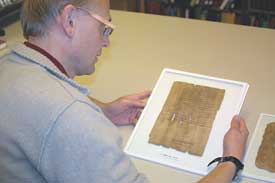It might look like a simple smudge, but even the slightest stain on the ancient writing surface of papyrus could obscure a revelation of a past civilization. Now, with the advent of high-tech imaging, some of those secrets could reveal fascinating insights into everyday life of early Egyptian, Greek and Roman societies.

Throughout June a team of national researchers and scholars examined dozens of papyri among the thousands of papyrological pieces in the U-M collection. Using multi-spectral imaging, the Ancient Textual Imaging Group — led by acclaimed papyrology expert Stephen Bay of Brigham Young University — examined ancient text written on papyrus that had become illegible because the pieces are stained, discolored and faded.
Recording through a range of filters, the technology captures high-resolution color images, making clear the layers of text hidden beneath words and letters written on superficial level of papyrus.
The Ancient Textual Imaging Group, based at Brigham Young, is conducting a two-year venture to capture illegible papyrus documents from historically significant U.S.-based collections. The project is supported by a grant from the National Endowment for the Humanities.
Throughout July scholars and students at the Papyrological Institute, hosted by U-M, will examine the newly recorded images, aiming to piece together a picture of a world that until now has been hidden by smudges and stains.
“These new images give us insight into the writing and life of generations existing two, maybe three generations before the readable text was written,” says Arthur Verhoogt, associate professor of papyrology and Greek studies.
The Papyrological Institute, which alternates among university locations annually, is sponsored by the American Society of Papyrologists. Since 2003 the institute has been at Yale University, University of California at Berkeley, University of Cincinnati, Columbia University and Stanford University.
Along with lectures and working first-hand with ancient texts, the scholars and students further their proficiency in Coptic and papyrological conservation. A form of Coptic is a common, colloquial Egyptian. Coptic flourished as a literary language from the second to 13th centuries.
Papyrus was used before the invention of paper around 1000 A.D. Everything from literary texts, police reports, legal decrees, letters from soldiers to shopping lists were recorded on the material that feels and looks much like papier mache.
Many papyri were reused with text on the back, or users would wash away text and write atop deleted words and phrases.

